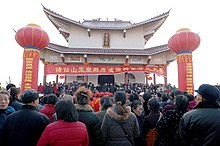Emperor Shun of Han was an emperor of the Chinese Han Dynasty and the eighth emperor of the Eastern Han. He reigned from December 125 to September 144.

Yixuan, formally known as Prince Chun, was an imperial prince of the House of Aisin-Gioro and a statesman of the Manchu-led Qing dynasty in China. He was the father of the Guangxu Emperor, and the paternal grandfather of Puyi through his fifth son Zaifeng.

Kongsi is a Hokkien transcription term meaning "company", especially businesses which have been incorporated. However, the word has other meanings under different historical contexts. Kongsi were most commonly known as Chinese social organizations or partnerships, but the term was also used for various Chinese institutions.

Chang Fei (Chinese: 張菲; pinyin: Zhāng Fēi; Pe̍h-ōe-jī: Tiuⁿ Húi ; born Chang Yan-ming is a Taiwanese singer and television personality.

is a county of the prefecture-level city of Quanzhou, in southern Fujian province, People's Republic of China. It lies adjacent to and directly north of Xiamen city.

Kuang is a Chinese surname originated from central China. Although Kuang is not amongst the 100 most common Chinese surnames, it is common amongst the Chinese diaspora in Hong Kong, Macau, Malaysia, Singapore, Vietnam, Philippines, United States, United Kingdom, Canada, Australia, Fiji, Thailand, Peru, Cuba, Burma, Indonesia and Reunion Island.
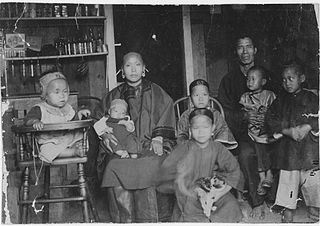
The Chinese kinship system is among the most complicated of all the world's kinship systems. It maintains a specific designation for almost every member's kin based on their generation, lineage, relative age, and gender. The traditional system was agnatic. based on patriarchal power, patrilocal residence, and descent through the male line. Although there has been much change in China over the last century, especially after 1949, there has also been substantial continuity.
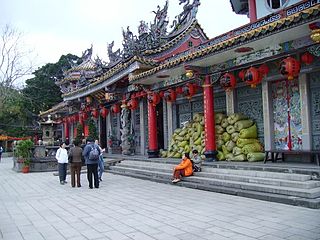
Chen Yuanguang, courtesy name Tingju, pseudonym Longhu, was a Tang dynasty general and official. He was from Gushi County, Henan. The people of Zhangzhou, Fujian, along with the descendants of immigrants from Zhangzhou to Taiwan, Singapore, Indonesia, and Malaysia, all refer to him as the "Sacred Duke, Founder of Zhangzhou".
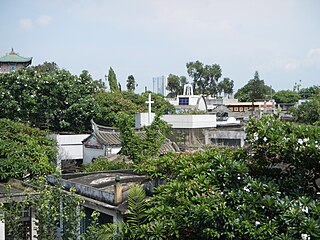
The Manila Chinese Cemetery is the second oldest cemetery in Manila after La Loma Cemetery. The cemetery includes Christian, Buddhist and Taoist burials. The present-day cemetery is a vaguely trapezoidal area of about 54 hectares with an irregular network of roads its old pre-war part along Rizal Avenue Extension, reflecting its gradual evolution and expansion. Meanwhile, the post-war portion has three major roads bisected by minor roads, aligned NW to SE. Matandang Sora, coming from the main entrance in Felix Huertas going towards Chong Hock Temple, is the main road today. Before the Pacific War the main entrances faced Avenida Rizal. This northwestern is the oldest and most historically significant part of the cemetery. The cemetery was witness to many executions during World War II. Among them were Girl Scouts organizer Josefa Llanes Escoda, Filipino Brigadier General and hero during World War II and Boy Scouts of the Philippines charter member Vicente Lim, literary geniuses Rafael Roces and Manuel Arguilla, star athlete-turned-guerrilla spy Virgilio Lobregat, and Chinese Consul General Yang Guangsheng. Apolinario Mabini was also buried in the cemetery before his remains were transferred to Batangas on July 23, 1956.

A spirit tablet, memorial tablet, or ancestral tablet is a placard that people used to designate the seat of a deity or past ancestor as well as to enclose it. The name of the deity or the past ancestor is usually inscribed onto the tablet. With origins in traditional Chinese culture, the spirit tablet is a common sight in many East Asian countries, where forms of ancestor veneration are practiced. Spirit tablets are traditional ritual objects commonly seen in temples, shrines, and household altars throughout Mainland China and Taiwan.
Xiangcheng District, or Sin Kang District in Min Nan, is a district of Zhangzhou, Fujian province, People's Republic of China.

Chinese ancestor veneration, also called Chinese ancestor worship, is an aspect of the Chinese traditional religion which revolves around the ritual celebration of the deified ancestors and tutelary deities of people with the same surname organised into lineage societies in ancestral shrines. Ancestors, their ghosts, or spirits, and gods are considered part of "this world". They are neither supernatural nor transcendent in the sense of being beyond nature. The ancestors are humans who have become godly beings, beings who keep their individual identities. For this reason, Chinese religion is founded on veneration of ancestors. Ancestors are believed to be a means of connection to the supreme power of Tian as they are considered embodiments or reproducers of the creative order of Heaven. It is a major aspect of Han Chinese religion, but the custom has also spread to ethnic minority groups.
Chen Zheng courtesy name Yimin, pseudonym Suxuan, was a Tang Dynasty general from Gushi County in Henan, China.

An ancestral shrine, hall or temple, also called lineage temple, is a temple dedicated to deified ancestors and progenitors of surname lineages or families in the Chinese tradition. Ancestral temples are closely linked to Confucian philosophy and culture and the emphasis that it places on filial piety.
Empress Dowager Huang, referred to semi-formally as Empress Dowager Longqi after her son Wang Yanjun 's Longqi era name, was an empress dowager of the Chinese Five Dynasties and Ten Kingdoms period state Min. She was the primary concubine of Wang Shenzhi, who was commonly regarded as the founder of the Min state, and the mother of Wang Yanjun, the first Min ruler to claim the title of emperor.

Seng Guan Ssu is a prominent Buddhist edifice on Narra Street, near Divisoria, in Tondo, Manila, Philippines. It contains a stupa, a huge repository for urns of human ashes, several meditation rooms, and various shrines. It is a major cultural center for the Chinese Filipino community. It is a Chan Buddhist temple built by the father of Buddhism in the Philippines, Master Xing Yuan from the South Putuo Temple in Xiamen, Fujian Province.

The House of Koxinga or the Zheng dynasty was the reigning family of the Kingdom of Tungning in Taiwan. They played a significant role in the history of East Asia and Southeast Asia, particularly in the seventeenth century.
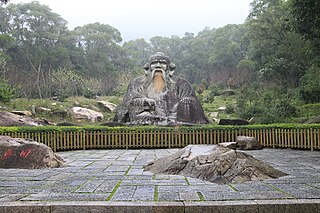
Minnan culture or Hokkien/Hoklo culture, also considered as the Mainstream Southern Min Culture, refers to the culture of the Hoklo people, a group of Han Chinese people who have historically been the dominant demographic in the province of Fujian in Southern China, Taiwan, and certain overseas Chinese communities in Southeast Asia, such as Singapore, Malaysia, the Philippines, Indonesia, Myanmar, Southern Thailand, Cambodia, Southern Vietnam, etc.

Hokkien architecture, also called Hoklo architecture or Minnan architecture, refers to the architectural style of the Hoklo people, a Han Chinese sub-group who have historically been the dominant demographic of the Southern Chinese province of Fujian ,and Taiwan, Singapore. This style shares many similarities with those of surrounding Han Chinese groups. There are, however, several features that are unique or mostly unique to Hoklo-made buildings, making many traditional buildings in Hokkien and Taiwan visually distinctive from those outside the region.

The Liu Clan Shrine is an ancestral shrine in Liouying District, Tainan, Taiwan.

